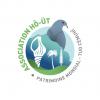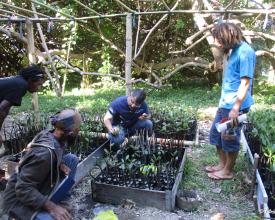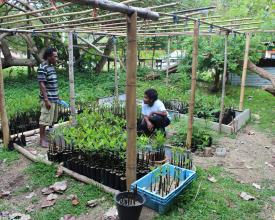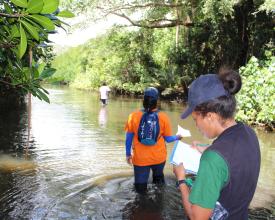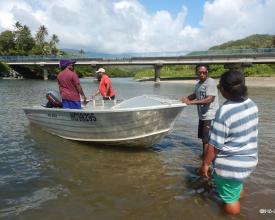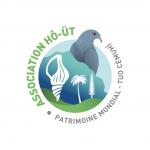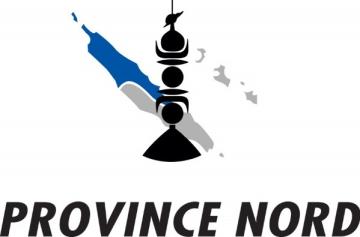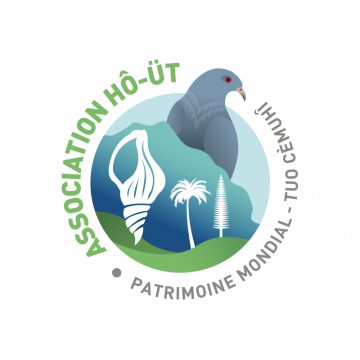
Participatory inventory of the Touho mangrove swamp
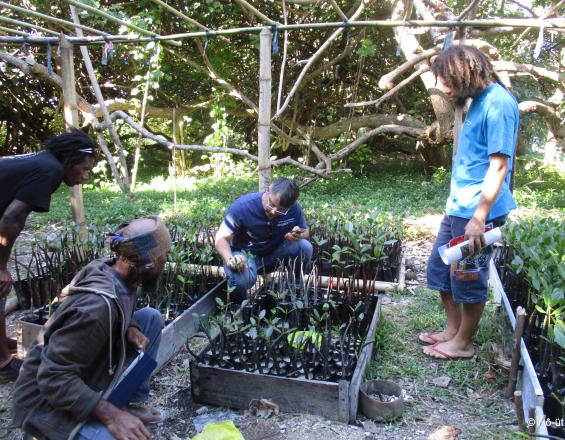
Implemented in New Caledonia and financed by the European BEST 2.0 program, the aim of the "Strengthening participative and integrated management of the UNESCO property on Touho" project was to strengthen participative management of the coastal zone - classified as a World Heritage Site by UNESCO since 2008 - through actions accessible to the entire population of Touho. The Hô-üt association was in charge of applying the World Heritage management plan, as well as implementing participatory actions at commune level. The project focused on the mangrove ecosystem, which provides us with food through gathering and fishing. This ecosystem also protects the coastline from tsunamis and cyclones, regulates the climate by capturing CO2, improves water quality by filtering it, is home to pollinating insects, has a strong cultural value, and represents an economic interest for tourism.
Context
Challenges addressed
- Training members of surrounding tribes (with no scientific background) in restoration techniques (GPS in particular) and protocols.
- Ensure that members are able to train others in turn.
- Involve the local population and support customary authorities in the species inventory, and find experienced field guides for the work carried out.
- Carrying out an inventory and characterizing the state of health of the mangrove over an area of 416 hectares with difficult access, using adapted means of transport such as 4x4s or boats.
- The creation and daily maintenance (watering, pest control, etc.) of a mangrove nursery for mangrove restoration.
- Involvement of the local population in participatory actions to restore the mangrove.
- Remote collaboration with a consulting firm for field data compilation and geo-spatial analysis.
Location
Process
Summary of the process
The first block, "Inventory and characterization of mangrove health", enabled us to take stock of the mangroves in the Touho commune - including identifying the plant species present and locating degraded areas. This enabled us to develop the second block, "Restoration of mangroves in degraded areas", to produce mangrove seedlings in nurseries, and to program the restoration of degraded sites on the basis of maps.
Building Blocks
Inventory and characterization of the mangrove's state of health
The various objectives of the Touho commune's environmental management plan are to inventory and map the floristic diversity of mangrove species throughout the commune, and to identify degraded mangroves. To this end, members of the Hô-üt association were trained in the identification of mangrove and back mangrove plant species, as well as in inventory techniques and the characterization of mangrove health. Field surveys consisted of recording a GPS point approximately every 50 meters within the Touho mangrove. At each point, participants made a 360° turn, noted all the plant species present, and characterized the state of health of the mangrove. The completed field sheets were then entered into the computer before being transferred to the consulting firm in charge of mapping. The latter then produced and delivered maps showing the distribution of mangrove species and their state of health, after GIS processing. The Hô-üt association then organized the presentation of this work to the customary authorities, the local population and the departments of the North Province.
Enabling factors
- Involvement of the local population in mangrove surveys around their homes.
- The support of the Department of Economic Development and the Environment for field surveys and the provision of GPS.
- The support of the traditional authorities in conveying the project's message to the Touho tribes, which facilitated its acceptance.
- The autonomy of association members to ensure reliable data collection.
- Training in inventory and characterization techniques and GPS use.
Lesson learned
- Make sure you spend enough time in the mangroves with an identification guide to familiarize yourself with the species.
- Make sure you have enough GPS units.
- Encourage the formation of teams in pairs, comprising an "expert" who has undergone training, and a novice who can be trained in this way.
- Ensure that the field survey protocol is followed to guarantee data reliability.
- Ensure that field data is entered on a daily basis.
- Present the data in spreadsheet form to facilitate the work of the design office.
- Do not hesitate to ask the design office for corrections to maps.
Restoration of mangroves in degraded areas
One of the objectives of the Touho commune's environmental management plan is to establish the Hô-üt association as a competent player in mangrove restoration. To this end, members of the association have been trained in restoration techniques. The restoration project began with the creation of a mangrove nursery in the Koé tribe. Members then collected propagules during the mangrove fruiting period, before placing them in horticultural bags. Two members of the Hô-üt association, residents of the Koé tribe, were in charge of maintaining the nursery (watering, replacing dead plants, etc.) until the plants were large enough to be transplanted. Based on maps of the mangrove's state of health, the association planned several plantations with the local population and a school in Touho. The association took care of transferring the seedlings to the planting sites, before preparing holes with crowbars and transplanting the mangroves. One of the restored areas had been degraded by logging for the construction of lime houses. As the old trees were eliminated, the mangrove gradually disappeared.
Enabling factors
- Training the association in restoration techniques
- Creation of a mangrove nursery
- Collect and bag propagules in the nursery
- Identification of a degraded area where natural recruitment is no longer assured.
- Communication and coordination of plantations with the local population
- Monitoring and maintenance of the nursery and plantations
- Support for the Northern Province in bagging propagules
- Support from Touho's traditional authorities for the commune's tribes.
Lesson learned
- Prefer member-to-member transmission of training directly in the field rather than in the classroom.
- Whenever possible, encourage the creation of a nursery close to the person in charge of its maintenance. This person must be motivated - maintenance should not be a constraint.
- Make sure that the mangrove was present on the selected restoration site before planting. If conditions are not favourable, the success of restoration activities may be compromised.
- Avoid planting where mangroves are showing signs of self-regeneration.
- Set planting dates outside customary events (weddings, festivals, ceremonies, etc.).
- Post planting dates and locations as close as possible to the most frequented places.
Impacts
This project has enabled members of the Hô-üt association to be trained in the identification of mangrove species and other coastal plants, and in the inventory protocol, as well as in the identification of mangrove restoration techniques, and mangrove planting and monitoring methods.
The association's members have in turn been able to train volunteers and provincial agents during field missions (mangrove mapping), or to pass on this knowledge beyond the Touho commune.
One of the main results of the study was the identification of degraded mangrove areas, as well as potential areas for mangrove replanting. These results led to the planning of two planting sessions, with a total of 800 mangroves planted on 5 sites.
Restoring degraded areas will enable the Touho mangrove to regain its original range, and thus provide numerous ecosystem services.
Ultimately, this project will have improved local knowledge of mangroves, and raised awareness among the Touho population of the importance of preserving and restoring this ecosystem.
Beneficiaries
The project has made it possible to plan the restoration of degraded mangroves, benefiting the local population. Other environmental associations in New Caledonia have benefited from this mangrove restoration experience.
Sustainable Development Goals
Story
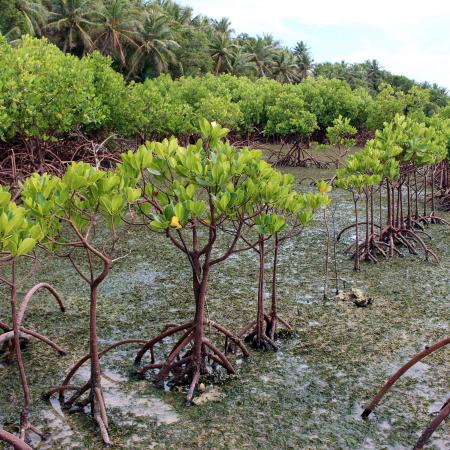
On September 25, 2018, members of the Hô-üt association were in the field to inventory plant species and characterize the state of health of the Touho mangrove. We had an appointment in the morning with a local woman to ask her permission to access the mangrove near her home. The woman, in her thirties, offered to take us through her property to access the mangrove, and to guide us to the seafront, which she knows perfectly well. Once there, she told us a story from her childhood: "When I was little, we often went down to the sea with Dad and my brothers and sisters to swim and fish. If one of us got into mischief, the punishment was to pick propagules from the mangroves along the beach and transplant them while the others enjoyed themselves. As a child, I didn't realize the importance of this gesture. Now that my father is gone, I realize that our elders were already well aware of the benefits of mangroves, and that we must continue to preserve them. Today, this woman regrets having been too wise back then!
